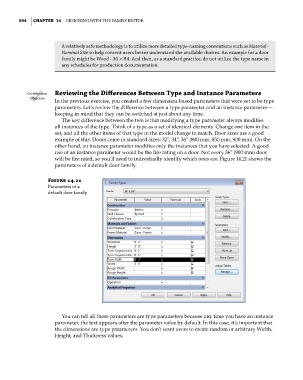Page 628 - Divyank Tyagi
P. 628
594 | ChaptEr 14 Designing with the Family eDitor
a relatively safe methodology is to utilize more detailed type-naming conventions such as Material -
Nominal Size to help content users better understand the available choices. an example for a door
family might be wood - 36 × 84. and then, as a standard practice, do not utilize the type name in
any schedules for production documentation.
Certification reviewing the Differences Between type and Instance parameters
Objective
In the previous exercise, you created a few dimension-based parameters that were set to be type
parameters. Let’s review the difference between a type parameter and an instance parameter—
keeping in mind that they can be switched at just about any time.
The key difference between the two is that modifying a type parameter always modifies
all instances of the type. Think of a type as a set of identical elements. Change one item in the
set, and all the other items of that type in the model change to match. Door sizes are a good
example of this. Doors come in standard sizes: 32”, 34”, 36” (800 mm, 850 mm, 900 mm). On the
other hand, an instance parameter modifies only the instances that you have selected. A good
use of an instance parameter would be the fire rating on a door. Not every 36” (900 mm) door
will be fire rated, so you’ll need to individually identify which ones are. Figure 14.21 shows the
parameters of a default door family.
Figure 14.21
Parameters of a
default door family
You can tell all these parameters are type parameters because any time you have an instance
parameter, the text appears after the parameter value by default. In this case, it’s important that
the dimensions are type parameters. You don’t want users to create random or arbitrary Width,
Height, and Thickness values.
c14.indd 594 5/3/2014 11:29:13 AM

